This QuickStart lists all the new and public beta features released, as well as bugs fixed in May 2024.
It is summary in nature, and you should refer to the specific Sigma documentation links provided for more information.
Public beta features will carry the section text "Beta".
All other features are considered released (GA or generally available).
Sigma actually has feature and bug fix releases weekly, and high-priority bug fixes on demand. We felt it was best to keep these QuickStarts to a summary of the previous month for your convenience.
New first Friday features QuickStarts will be published on the first Friday of each month, and will include information for the previous month.

OAuth write access (Beta)
Configure an OAuth connection with write access to leverage the benefits of OAuth permission management with Sigma's write-access features, including input tables, warehouse views, workbook materializations, and CSV uploads.
For more information, see Configure OAuth with write access.
Organization translation files
We have made it easier to serve Sigma users in your organization and consumers of embedded analytics with content in their preferred language.
Sigma admins can create organization-wide translation files to translate custom strings that are common across workbooks in an organization, saving time and ensuring a consistent experience.
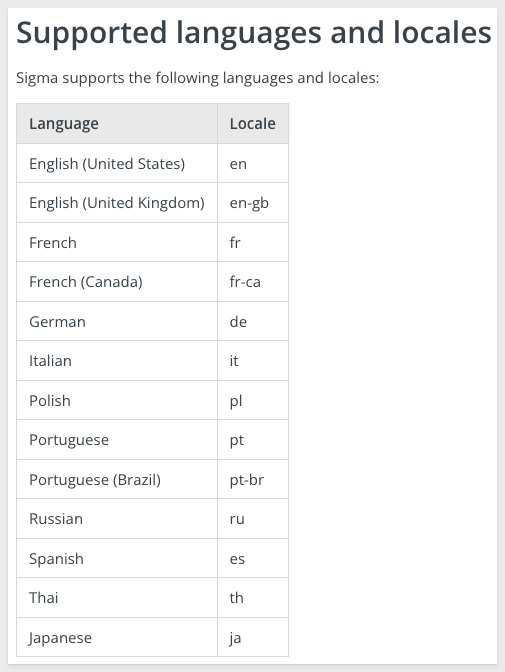
Workbook owners inherit the organization-level translations and can override and supplement them with translations unique to an individual workbook. For more information, see:
Manage organization translation filesManage workbook localizationNew translations API endpoints

New API reference and recipes
We have migrated to a new API Reference platform that is far more feature rich while being easier to use.
All API reference documentation has moved here.
The new structure for the API reference offers better in-line documentation for endpoints and interactive code samples in a variety of languages:
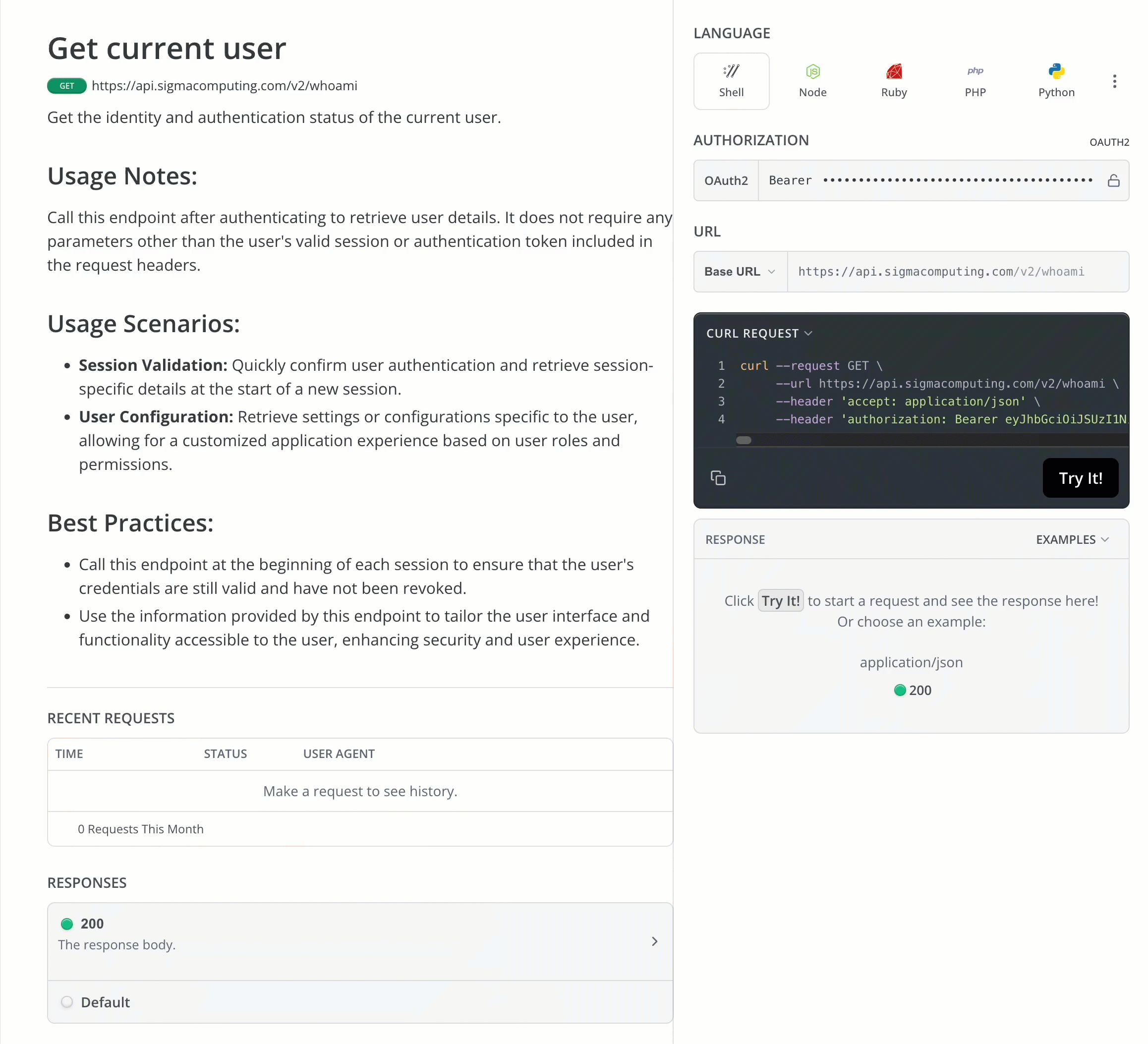
In addition, we have published API code samples (Recipes) and a corresponding QuickStart that walks you through real-world code examples using the API.
All the current "Recipes" are written in JavaScript today. The recipes can be downloaded individually from the Recipes page and are also available in a public Git repository.
The following Recipes are available today:
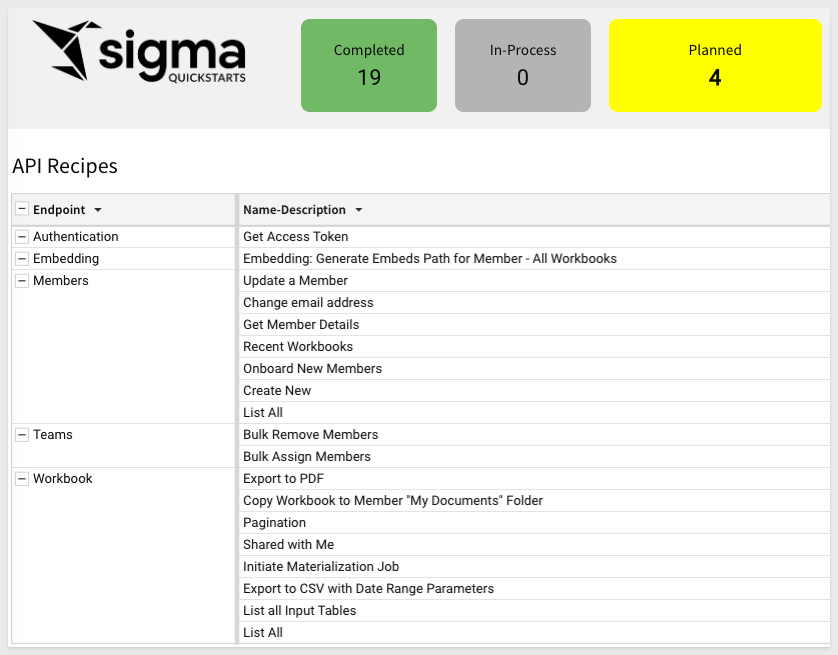
SUPPORT_CHATS audit log dimension table
We have added a new log table that provides reference information about user interactions with Sigma's live chat support feature.
The SIGMA_SHARED schema in the Sigma Audit Logs connection now features a SUPPORT_CHATS dimension table containing information about individual live chat conversations, including timestamp, user name, user email, and the full chat transcript.
Customers can build a dashboard or report that includes this information to allow others to access or be updated on support status.

1: Administrators can no longer circumvent UI restrictions to raise privileges of guest and embed users.
2: Sigma no longer throws an error when multiple embeds attempt to add a new user at the same time.
3: In the Administration > Embeds page, you can now successfully preview an embed in the Embed Sandbox when you click More and select Test embed.
4: When viewing an individual embed user's profile in the Administration > People page, the Edit member and account type modal now displays "Embed user" in the Account type field instead of "Invalid selection."
**5:**A user's Sigma access token now expires when the OAuth access token expires, ensuring the user is logged out when the OAuth session has ended.
**6:**Updates to filters and sorting in tagged workbook versions are now reflected in exports and no longer trigger errors.

CSV input tables
You can now pre-populate a new input table with uploaded CSV data that you can then edit at the cell level.
Like empty input tables, CSV input tables support data entry independent of existing data, enabling you to add editable rows and columns to construct the table as you see fit.
For more information, see Intro to input tables and Create new input tables.
There is also a QuickStart that covers several common use cases here.

Embed Events (formally known as Action and Events):
To avoid confusion with Sigma's new Actions feature, we have renamed embedded Actions and Events to Embed Events.
There are two types: Inbound Events: Are variables sent from the Parent application to Sigma. There is no "listener" to code into the iframe; Sigma handles that out-of-the-box. Sigma can use these messages to update control values. For example, passing a new value to a Sigma control that is used to filter table data.
Inbound events can be passed using either JavaScript or URL.
Out-bound Events: Are variables sent from Sigma to the Parent application which must have a "listener" coded into the Parent application to receive and react to the message as desire
For more information, see Implement inbound and outbound events in embeds.
Embed Events are discussed and demonstrated in this QuickStart.
New Embedded Events
Sigma has added many new events to support existing and new functionality.
New Inbound events:
workbook:bookmark:create
workbook:fullscreen:update
workbook:selectednodeid:update
workbook:variables:list
workbook:variables:update
New Outbound events:
url:onchange
workbook:bookmark:oncreate
workbook:bookmark:update
workbook:chart:error
workbook:dataloaded
workbook:error
workbook:fullscreen:onchange
workbook:id:onchange
workbook:pageheight:onchange
workbook:pivottable:oncellselect
workbook:published
For more information, see Implement inbound and outbound events in embeds.
There is also a QuickStart for using events with Sigma embedding.
nodeType property for workbook:selectednodeid:update
We have added the ability to programmatically determine whether a selected node is a page or an element by referencing the nodeType property in the inbound event.
workbook:selectednodeid:update
For more information, see Available inbound events.

Sigma REST API Recipes
This QuickStart is designed to support Sigma's API Recipes and demonstrates many common operations that customers may use the REST API for.
Dynamic button text
You can now add dynamic values to button elements.
When configuring the button text, enter = to include a dynamic value defined by a formula expression.
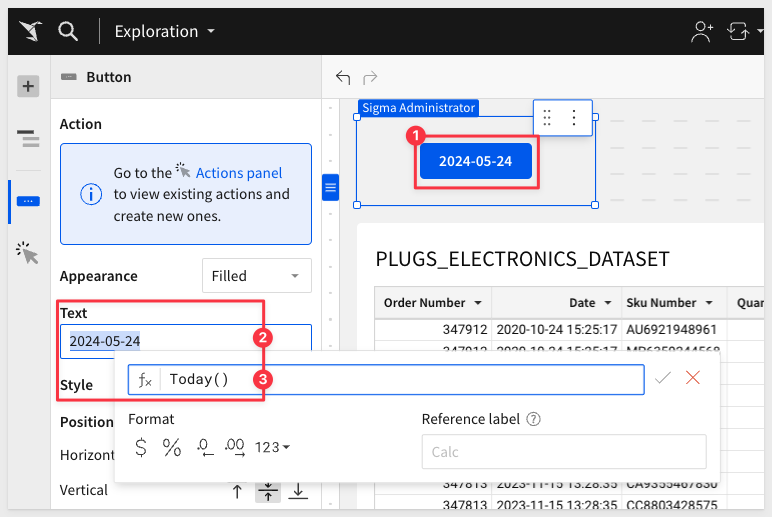
For more information about buttons, see Create a button element.

Custom formula aggregations in chart reference marks
You can now specify a custom formula aggregation when configuring reference marks in charts.
For more information about reference marks, see Display chart reference marks.
Data labels in maps
Add one or more columns to generate data labels in point and region maps. This update makes it easier to quickly view at-a-glance details directly in the element.
For more information, see Display chart data labels.
Default version tags
Users with Can edit workbook permission can now designate a tag as the default tag for a workbook. As a result, any user who does not have access to the Published workbook will see the default tagged version.
Applying default tags to workbooks with multiple tags results in a more consistent viewing experience.
For more information, see Set a default tag for a workbook.
Donut hole value in donut charts
Display an aggregate value within the hole of a donut chart to add more context to your visualization.
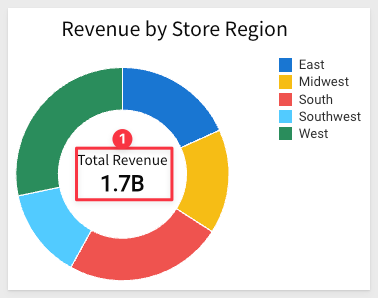
For details about adding a donut hole value, see Pie and donut charts.
Embedding Sigma's documentation now supported
Many customers provide useful information on how to best use Sigma workbooks directly in the workbook itself.
There are time when it can be used to embed specific Sigma documentation content from the Sigma help pages.
This is quite easy to do now using the Embed element
For example, you may want to provide a basic introduction to your new users on how to get started with Sigma:
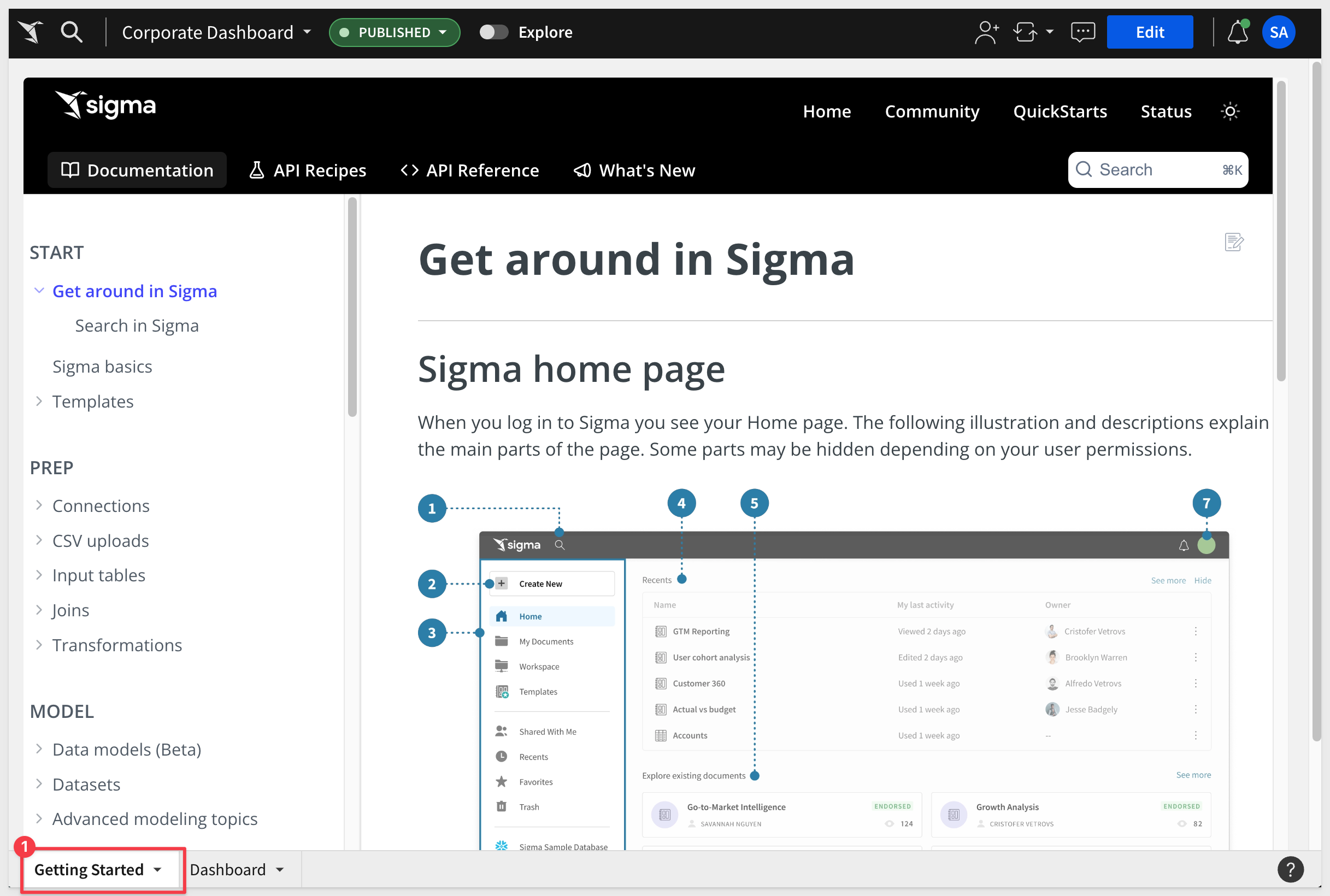
Another example is to provide the list of popular functions that are available:
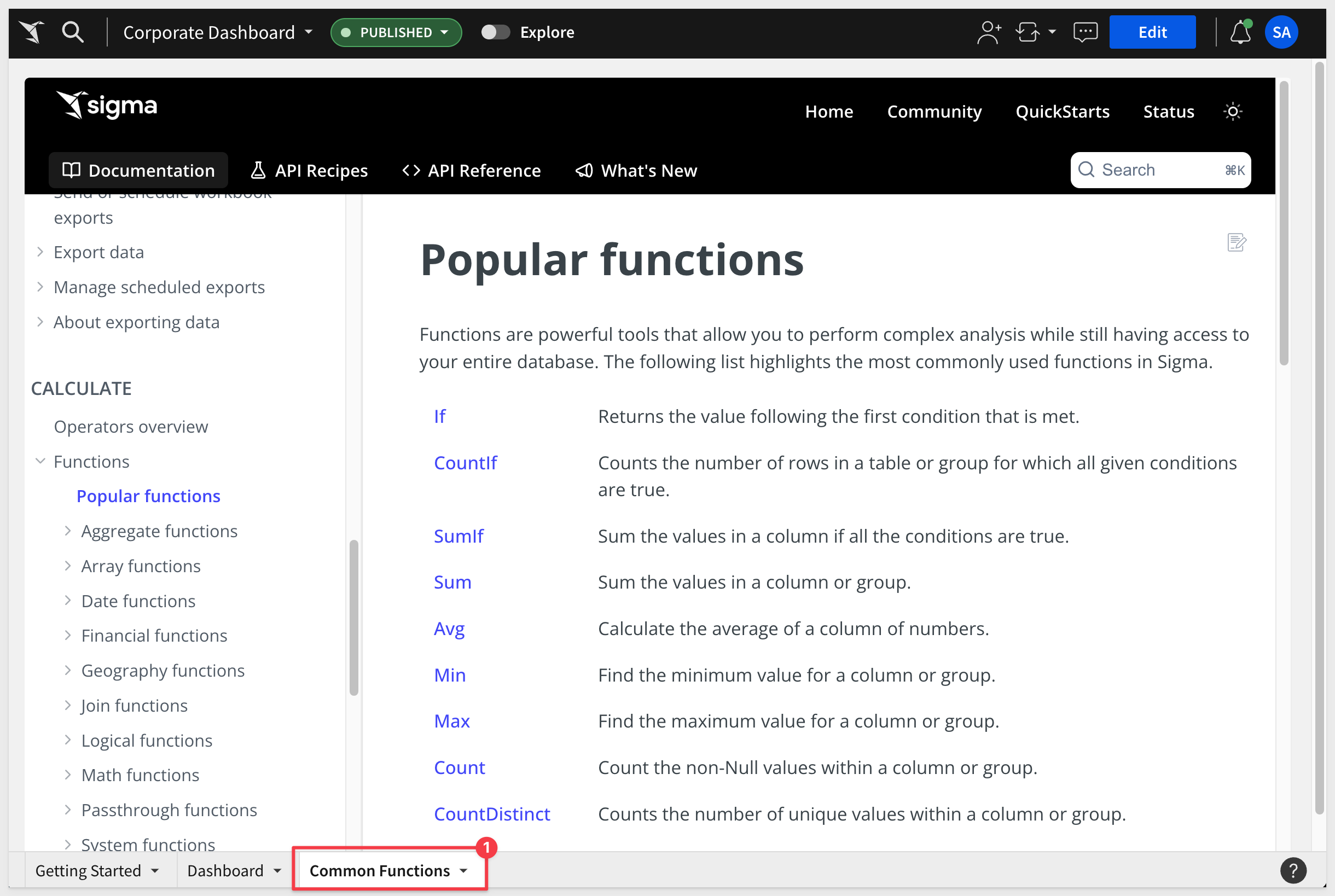
Users will appreciate the time saved by avoiding opening another browser page to access documentation.
Enhanced SQL editor (Beta)
We have added a new, in-line SQL editor that allows SQL users to write their code directly in the workbook, and reference / build on top of other elements in the workbook.
Use the new SQL editor—featuring a more integrated and collaborative experience—to build workbooks, datasets, and elements (tables, pivot tables, and visualizations) with custom SQL.
The Beta release includes the following enhanced capabilities:
- Toggle to an inline SQL editor view within any SQL-based workbook element, and expand the element to enter full screen mode.
- Collaborate with other workbook developers in a live editing environment.
- Use search and replace functionality within the custom SQL.
- Apply autocomplete suggestions featuring improved performance.
- View and access custom SQL from the workbook Lineage view.
For more information about using custom SQL directly in Sigma, see Write custom SQL.
For a video demonstration, click here.
Improved data source selection UI
Select data sources for workbook elements using a new popover UI.
With the new experience, you can search for data sources, review a list of suggested sources, and preview data sources.
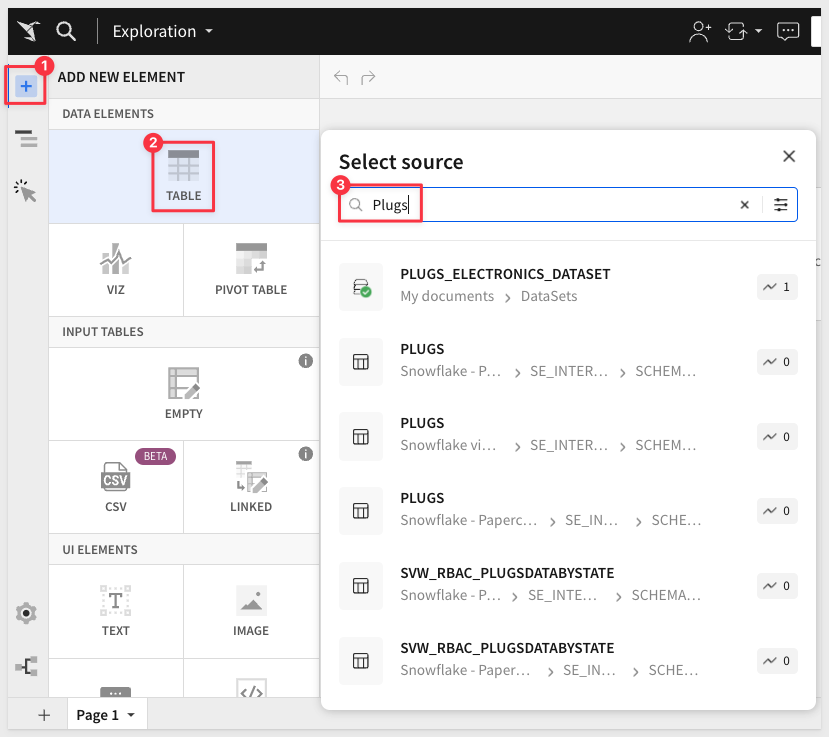
Preview a data source to review the source data and choose specific columns to apply to the element:
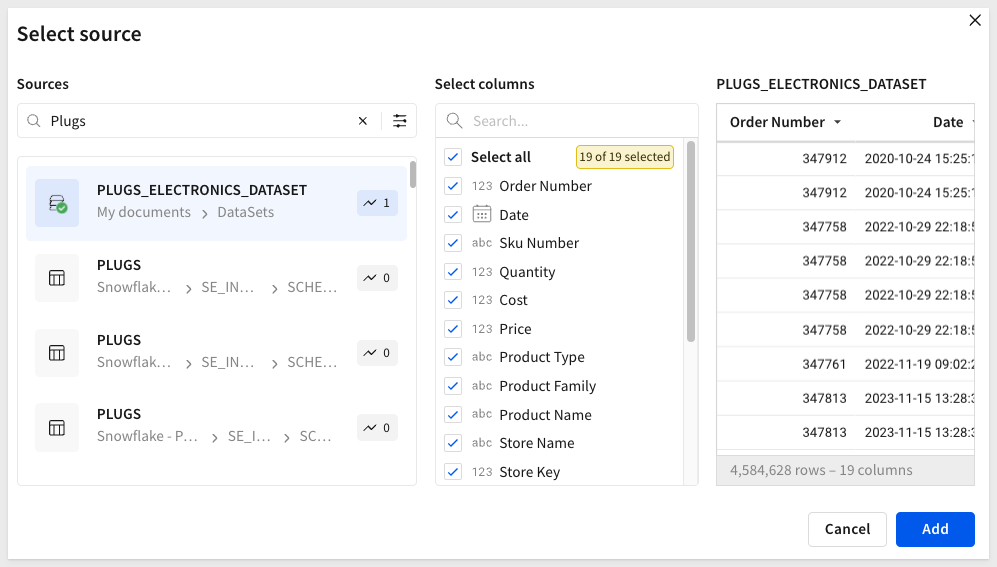
For more information, see Create a data element.

Additional Resource Links
Blog
Community
Help Center
QuickStarts



